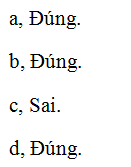Hãy nhập câu hỏi của bạn vào đây, nếu là tài khoản VIP, bạn sẽ được ưu tiên trả lời.

Cho hai véc tơ \(\overrightarrow{a};\overrightarrow{b}\).
TenAnh2
TenAnh2
A = (-4.3, -5.94)
A = (-4.3, -5.94)
A = (-4.3, -5.94)
B = (11.06, -5.94)
B = (11.06, -5.94)
B = (11.06, -5.94)
D = (10.84, -5.94)
D = (10.84, -5.94)
D = (10.84, -5.94)
E = (-4.36, -5.86)
E = (-4.36, -5.86)
E = (-4.36, -5.86)
F = (11, -5.86)
F = (11, -5.86)
F = (11, -5.86)
TenAnh1 TenAnh1 A = (-4.3, -5.94) A = (-4.3, -5.94) A = (-4.3, -5.94) B = (11.06, -5.94) B = (11.06, -5.94) B = (11.06, -5.94) D = (10.84, -5.94) D = (10.84, -5.94) D = (10.84, -5.94) F = (11, -5.86) F = (11, -5.86) F = (11, -5.86) E = (-4.3, -5.98) E = (-4.3, -5.98) E = (-4.3, -5.98) G = (11.06, -5.98) G = (11.06, -5.98) G = (11.06, -5.98)

a) Theo giả thiết \(\overrightarrow{a}=\overrightarrow{b}\ne\overrightarrow{0}\) nên giả sử \(\overrightarrow{a}=m\overrightarrow{b}\) suy ra:
\(\overrightarrow{a}=m\overrightarrow{a}\Leftrightarrow\left(1-m\right)\overrightarrow{a}=\overrightarrow{0}\).
\(\Leftrightarrow1-m=0\) (vì \(\overrightarrow{a}\ne\overrightarrow{0}\) ).
\(\Leftrightarrow m=1\).
b) Nếu \(\overrightarrow{a}=-\overrightarrow{b};\overrightarrow{a}\ne\overrightarrow{0}\).
Giả sử \(\overrightarrow{a}=m\overrightarrow{b}\Leftrightarrow\overrightarrow{a}=-m\overrightarrow{a}\)\(\Leftrightarrow\overrightarrow{a}\left(1+m\right)=\overrightarrow{0}\)
\(\Leftrightarrow1+m=0\)\(\Leftrightarrow m=-1\).
c) Do \(\overrightarrow{a}\) , \(\overrightarrow{b}\) cùng hướng nên: \(m>0\).
Mặt khác: \(\overrightarrow{a}=m\overrightarrow{b}\Leftrightarrow\left|\overrightarrow{a}\right|=\left|m\right|.\left|\overrightarrow{b}\right|\)
\(\Leftrightarrow20=5.\left|m\right|\)\(\Leftrightarrow\left|m\right|=4\)
\(\Leftrightarrow m=\pm4\).
Do m > 0 nên m = 4.
d) Do \(\overrightarrow{a},\overrightarrow{b}\) ngược hướng nên m < 0.
\(\left|\overrightarrow{a}\right|=\left|m\right|.\left|\overrightarrow{b}\right|\)\(\Leftrightarrow15=\left|m\right|.3\)\(\Leftrightarrow\left|m\right|=5\)\(\Leftrightarrow m=\pm5\).
Do m < 0 nên m = -5.
e) \(\overrightarrow{a}=\overrightarrow{0};\overrightarrow{b}\ne\overrightarrow{0}\) nên\(\overrightarrow{0}=m.\overrightarrow{b}\). Suy ra m = 0.
g) \(\overrightarrow{a}\ne\overrightarrow{0};\overrightarrow{b}=\overrightarrow{0}\) nên \(\overrightarrow{a}=m.\overrightarrow{0}=\overrightarrow{0}\). Suy ra không tồn tại giá trị m thỏa mãn.
h) \(\overrightarrow{a}=\overrightarrow{0};\overrightarrow{b}=\overrightarrow{0}\) nên \(\overrightarrow{0}=m.\overrightarrow{0}\). Suy ra mọi \(m\in R\) đều thỏa mãn.

A B C D O M N
a)
Các véc tơ cùng phương với \(\overrightarrow{AB}\) là:
\(\overrightarrow{MO};\overrightarrow{OM};\overrightarrow{MN};\overrightarrow{NM};\overrightarrow{NO};\overrightarrow{ON};\overrightarrow{DC};\overrightarrow{CD};\overrightarrow{BA};\overrightarrow{AB}\).
Hai véc tơ cùng hướng với \(\overrightarrow{AB}\) là:
\(\overrightarrow{MO};\overrightarrow{ON}\).
Hai véc tơ ngược hướng với \(\overrightarrow{AB}\) là:
\(\overrightarrow{OM};\overrightarrow{ON}\).
b) Một véc tơ bằng véc tơ \(\overrightarrow{MO}\) là: \(\overrightarrow{ON}\).
Một véc tơ bằng véc tơ \(\overrightarrow{OB}\) là: \(\overrightarrow{DO}\).

a) \(\dfrac{2}{-10}=\dfrac{3}{-15}\) nên hai véc tơ \(\overrightarrow{a};\overrightarrow{b}\) cùng phương.
\(\left(-10;-15\right)=-5\left(2;3\right)\Rightarrow\overrightarrow{b}=-5\overrightarrow{a}\) nên hai véc tơ \(\overrightarrow{a};\overrightarrow{b}\) ngược hướng.
b) \(\left(0;8\right)=\dfrac{8}{7}\left(0;7\right)\) nên \(\overrightarrow{v}=\dfrac{8}{7}\overrightarrow{u}\) nên hai véc tơ \(\overrightarrow{u};\overrightarrow{v}\) cùng hướng.
c) \(\left(-6;3\right)=3\left(-2;1\right)\) nên \(\overrightarrow{n}=3\overrightarrow{m}\) nên hai véc tơ \(\overrightarrow{m};\overrightarrow{n}\) cùng phướng và cùng hướng.
d) Hai véc tơ cùng phương và cùng hướng.
e) \(\overrightarrow{e}\) cùng hướng với véc tơ \(\overrightarrow{j}\); \(\overrightarrow{f}\) cùng hướng với véc tơ \(\overrightarrow{i}\).
Nên hai veca tơ \(\overrightarrow{e}\) và \(\overrightarrow{f}\) không cùng phương.

\(\left|\overrightarrow{a}+\overrightarrow{b}\right|^2=\left(\overrightarrow{a}+\overrightarrow{b}\right)\left(\overrightarrow{a}+\overrightarrow{b}\right)\)
\(=\left|\overrightarrow{a}\right|^2+\left|\overrightarrow{b}\right|^2+2\overrightarrow{a}.\overrightarrow{b}\)
\(=5^2+12^2+2.5.12.cos\left(\overrightarrow{a},\overrightarrow{b}\right)\)
\(=169+120cos\left(\overrightarrow{a},\overrightarrow{b}\right)=13^2\)
Suy ra: \(cos\left(\overrightarrow{a};\overrightarrow{b}\right)=0\).
\(\overrightarrow{a}\left(\overrightarrow{a}+\overrightarrow{b}\right)=\left(\overrightarrow{a}\right)^2+\overrightarrow{a}.\overrightarrow{b}=5^2+5.12.0=25\).
Mặt khác \(\overrightarrow{a}\left(\overrightarrow{a}+\overrightarrow{b}\right)=\left|\overrightarrow{a}\right|.\left|\overrightarrow{a}+\overrightarrow{b}\right|.cos\left(\overrightarrow{a},\overrightarrow{a}+\overrightarrow{b}\right)\)
\(=5.13.cos\left(\overrightarrow{a},\overrightarrow{a}+\overrightarrow{b}\right)\).
Vì vậy \(25=5.13.cos\left(\overrightarrow{a},\overrightarrow{a}+\overrightarrow{b}\right)\).
\(cos\left(\overrightarrow{a},\overrightarrow{a}+\overrightarrow{b}\right)=\dfrac{5}{13}\).
Vậy góc giữa hai véc tơ \(\overrightarrow{a}\) và \(\overrightarrow{a}+\overrightarrow{b}\) là \(\alpha\) sao cho \(cos\alpha=\dfrac{5}{13}\).


a) Gọi theo thứ tự ∆1, ∆2, ∆3 là giá của các vectơ ,
,  ,
, 
Từ (1), (2) suy ra ∆1 // ∆2 ( hoặc ∆1 = ∆2 ), theo định nghĩa hai vectơ ,
,  cùng phương.
cùng phương.
Vậy câu a) đúng.
b) Câu này cũng đúng.